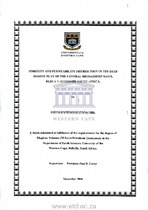| dc.description.abstract | This study describes porosity and permeability distribution in the deep marine play of the central Bredasdorp Basin, Block 9, offshore South Africa using methods that include thin section petrography, X-ray diffraction, and scanning electron microscopy, in order to characterize their porosity and permeability distributions, cementation and clay types that affect the porosity and permeability distribution. The study includes core samples from nine wells taken from selected depths within the Basin. Seventy three thin sections were described using parameters such as grain size measurement, quantification of porosity and permeability, mineralogy, sorting, grain shape, matrix, cementation, and clay content. Core samples were analyzed using x-ray diffraction for qualitative clay mineralogy and phase analysis. Scanning electron microscope analysis for qualitative assessment of clays and cements. X-ray diffraction (XRD) and scanning electron microscope (SEM) analyses were conducted on fifty-four (54) and thirty-five (35) samples respectively to identify and quantify the clay mineralogy of the sandstones. The SEM
micrographs are also useful for estimating the type and distribution of porosity and cements. Analyses of these methods is used in describing the reservoir quality. Detrital matrix varies in abundance from one well to another. The matrix consists predominantly of clay minerals with lesser amounts of detrital cements. X-ray diffraction analyses suggest these clays largely consist of illitic and kaolinite, with minor amounts of
chlorite and laumontite. Because these clays are highly illitic, the matrix could exhibit significant swelling if exposed to fresh sea water, thus further reducing the reservoir quality. The majority of the samples generally have significant cements; in particular quartz cement occurs abundantly in most samples. The high silica cement is possibly caused by the high number of nucleation sites owing to the relatively high abundance of detrital quartz. Carbonate cement, particularly siderite and calcite, occurs in variable amounts in most samples but generally has little effect on reservoir quality in the majority of samples. Authigenic, pore-filling kaolinite occurs in several samples and is probably related. to feldspar/glauconite alteration, it degrades reservoir quality. The presence of chlorite locally (plate 4.66A & B) and in minute quantities is attributed to a late stage replacement of lithic grains. Don't put references to plates and figures in abstract. A high argillaceous content is directly responsible for the low permeability obtained in the core analysis. Pervasive calcite and silica cementation are the main cause of porosity and permeability destruction. Dissolution of pore filling intergranular clays may result in the formation of micro porosity and interconnected secondary porosity. Based on the combination of information derived from thin section petrography, SEM and
XRD, diagenetic stages and event sequences are established for the sandstone in the studied area. Reservoir quality deteriorates with depth, as cementation, grain coating and pore infilling authigenic chlorite, illite and kaolinite becomes more abundant. | en_US |

